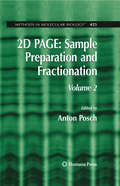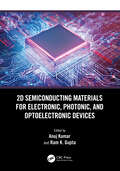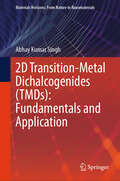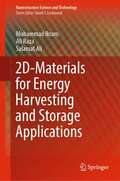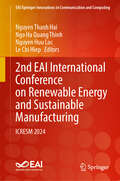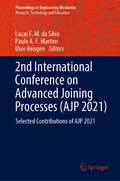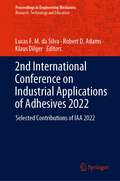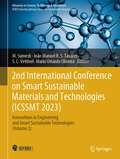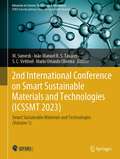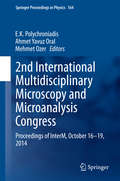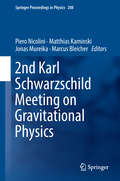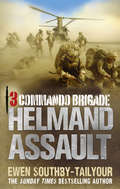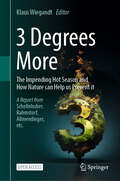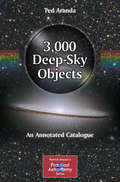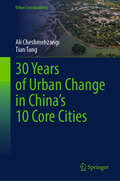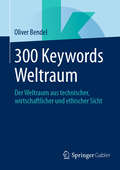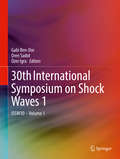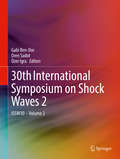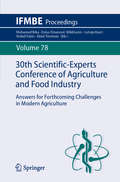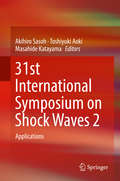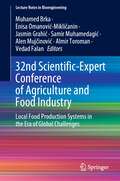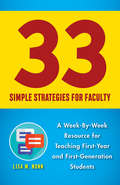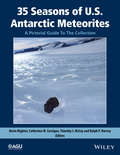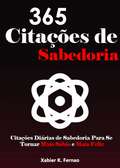- Table View
- List View
2D PAGE: Volume 2 (Methods in Molecular Biology #425)
by Anton PoschThe complex nature of proteins often requires a multitude of sample preparation options. In 2D PAGE: Sample Preparation and Fractionation, Volumes 1 & 2, Dr. Anton Posch presents a broad coverage of the principles and recent developments of sample preparation and fractionation tools in Expression Proteomics and specifically for two-dimensional electrophoresis (2-DE). Detailed laboratory methods describe the process of sample fractionation used to reduce the complexity of the protein sample and the methods of 2-DE analysis and a broad variety of gel-free mass spectrometry-based technologies to detect previously undetectable proteins. Vital information regarding protein isolation and preparation for reproducible proteome analysis previously overlooked by scientists has been clearly laid out in this pioneering two-volume set. Volume 2 illuminates specific applications of sample preparation tools and fractionation strategies to study a variety of biological systems.<P><P> Invaluable for students of Biochemistry, Biomedicine, Biology and Genomics and essential for the practicing scientists, 2D PAGE: Sample Preparation and Fractionation, Volumes 1 & 2 delves into the study of proteins with comprehensive and in depth methods and protocols to provide a greater understanding of this intricate and complicated field.
2D Semiconducting Materials for Electronic, Photonic, and Optoelectronic Devices
by Anuj Kumar Ram K. GuptaTwo-dimensional semiconducting materials (2D-SCMs) are the subject of intensive study in the fields of photonics and optoelectronics because of their unusual optical, electrical, thermal, and mechanical properties. The main objective of 2D Semiconducting Materials for Electronic, Photonic, and Optoelectronic Devices is to provide current, state-of-the-art knowledge of two-dimensional semiconducting materials for various applications. Two-dimensional semiconducting materials are the basic building blocks for making photodiodes, light-emitting diodes, light-detecting devices, data storage, telecommunications, and energy-storage devices. When it comes to two-dimensional semiconducting materials, electronic, photonic, and optoelectronic applications, as well as future plans for improving performance, no modern book covers as much ground. The planned book will fill such gaps by offering a comprehensive analysis of two-dimensional semiconducting materials. This book covers a range of advanced 2D materials, their fundamentals, and the chemistry for many emerging applications. All the chapters are covered by experts in these areas around the world, making this a suitable textbook for students and providing new guidelines to researchers and industries. • Covers topics such as fundamentals and advanced knowledge of two-dimensional semiconducting materials • Provides details about the recent methods used for the synthesis, characterization, and applications of two-dimensional semiconducting materials • Covers the state-of-the-art development in two-dimensional semiconducting materials and their emerging applications This book provides directions to students, scientists, and researchers in semiconductors and related disciplines to help them better understand the physics, characteristics, and applications of 2D semiconductors.
2D Transition-Metal Dichalcogenides (Materials Horizons: From Nature to Nanomaterials)
by Abhay Kumar SinghThis book offers to reader a sound understating of two-dimensional Transition-Metal Dichalcogenides (2D TMDs) materials, detailing their physio-chemical mechanisms and technological applications in various areas such as nanoelectronics and optoelectronics. Moving from their invention to their modern developments, including theoretical approaches, experimental interpretations and their technical applications, the book explores the basic concepts of 2D TMDs. It will be of interest to undergraduate and postgraduate students, researchers and scientists working in the area of 2D TMDs. A key goal of this book provides a sound or clear idea about two-dimensional Transition-Metal Dichalcogenides (2D TMDs) materials by providing their sound background, fabrication approaches including interpretations of the inside physio-chemical mechanism including technological applications in various significant areas such as nanoelectronics, optoelectronics, topological insulators, biomedical.
2D-Materials for Energy Harvesting and Storage Applications (Nanostructure Science and Technology)
by Ali Raza Muhammad Ikram Salamat AliThis authored monograph presents the state-of-the-art improvements in 2D materials, focusing on their most significant achievements, as well as recent emergence and potential applications. The book discusses synthetic protocols as well as the structural chemistry and physical properties of various 2D materials and explores their energy-related utilization. The main energy harvesting applications such as piezoelectric generators, solar cells and hydrogen evolution reactions are analyzed, while special focus is also given to the related energy storage technologies such as rechargeable batteries, supercapacitors and wearable energy storage devices. This volume sheds new light on 2D materials and their applications and will be a useful tool for graduates and academics working in the fields of materials science, materials physics and chemistry.
2nd EAI International Conference on Renewable Energy and Sustainable Manufacturing: ICRESM 2024 (EAI/Springer Innovations in Communication and Computing)
by Nguyen Thanh Hai Ngo Ha Quang Thinh Nguyen Huu Loc Le Chi HiepThis book compiles the proceedings of the 2nd EAI International Conference on Renewable Energy and Sustainable Manufacturing (ICRESM 2024), held in Ho Chi Minh City, Vietnam, on November 2–3, 2024. The conference provided a collaborative forum for researchers, industry experts, policymakers, and stakeholders to exchange insights, innovations, and best practices in sustainable technologies aimed at reducing dependence on non-renewable resources and advancing Industry 4.0 initiatives. The included papers explore global challenges in sustainable manufacturing, energy security, and green technologies, highlighting applications that contribute to carbon emission reduction, environmental protection, and economic growth through renewable energy and eco-friendly production methods. This collection offers valuable perspectives on the latest technological developments, methodologies, and strategies driving progress in these fields. Features the proceedings of the 2nd EAI International Conference on Renewable Energy and Sustainable Manufacturing; Showcases advancements in renewable energy and sustainable manufacturing technologies; Provides valuable insights for researchers, practitioners, and policymakers interested in cutting-edge innovations and best practices.
2nd International Conference on Advanced Joining Processes: Selected Contributions of AJP 2021 (Proceedings in Engineering Mechanics)
by Lucas F. M. da Silva Paulo A. F. Martins Uwe ReisgenThis book focusses on all advanced methods of joining such as friction stir welding, joining by plastic deformation, laser welding, advanced mechanical joining, adhesive bonding and hybrid joining. The volume presents the state-of-the-art of advanced methods of joining and also serves as a reference for researchers and graduate students working in this field.This book gathers selected contributions of the 2nd International Conference on Advanced Joining Processes 2021, held in Sintra, Portugal, on October 21–22, 2021.
2nd International Conference on Industrial Applications of Adhesives 2022: Selected Contributions of IAA 2022 (Proceedings in Engineering Mechanics)
by Robert D. Adams Lucas F. M. da Silva Klaus DilgerThis book provides selected papers presented at the 2nd International Conference on Industrial Applications of Adhesives 2022, held in Carvoeiro, Portugal, 3-4 March 2022.The volume focuses on applications of adhesive bonding in the industry such as automotive, aeronautic, railway, marine, energy, and electronics. A wide range of topics like adhesion assessment between polymers and metals, pressure sensitive adhesives, adhesive bonding process optimization, civil applications, adhesive joints in composite materials and elastic adhesives are covered.The book presents the latest results and innovations in this field, useful for adhesive producers and adhesive users.
2nd International Conference on Smart Sustainable Materials and Technologies: Innovations in Engineering and Smart Sustainable Technologies (Volume 2) (Advances in Science, Technology & Innovation)
by João Manuel R. S. Tavares S. C. Vettivel M. Sumesh Mario Orlando OliveiraSustainable materials science and engineering is one of the important characteristics of the existing high-tech revolution. The advances of materials science pave way for technical advancements in materials science and industrial technologies throughout the world. Materials are regarded as critical component in all emerging industries. Exquisite preparation and manufacturing must be carried out before a new material may be used. Nevertheless, electronic materials are undeniably important in many aspects of life. Smart materials and structures is a multi-disciplinary platform dedicated to technical advances in smart materials, systems and structures, including intelligent materials, sensing and actuation, adaptive structures, and active control. Recently, sustainable materials and technologies reshape the electronics industry to build realistic applications. At present, without the impact of sustainability, the electronics industry faces challenges. Researchers are now more focused on understanding the fundamental science of nano, micro, and macro-scale aspects of materials and technologies for sustainable development with a special attention toward reducing the knowledge gap between materials and system designs. The main aim of this international conference is to address the new trends on smart sustainable materials field for industrial and electronics applications. The main purpose of this conference is to assess the recent development in the applied science involving research activity from micro- to macro-scale aspects of materials and technologies for sustainable applications. In such a context, particular emphasis is given to research papers tailored in order to improve electronic and industrial applications and market extension of sustainable materials.
2nd International Conference on Smart Sustainable Materials and Technologies: Smart Sustainable Materials and Technologies (Volume 1) (Advances in Science, Technology & Innovation)
by João Manuel R. S. Tavares S. C. Vettivel M. Sumesh Mario Orlando OliveiraSustainable materials science and engineering is one of the important characteristics of the existing high-tech revolution. The advances of materials science pave way for technical advancements in materials science and industrial technologies throughout the world. Materials are regarded as critical component in all emerging industries. Exquisite preparation and manufacturing must be carried out before a new material may be used. Nevertheless, electronic materials are undeniably important in many aspects of life. Smart materials and structures is a multi-disciplinary platform dedicated to technical advances in smart materials, systems and structures, including intelligent materials, sensing and actuation, adaptive structures, and active control. Recently, sustainable materials and technologies reshape the electronics industry to build realistic applications. At present, without the impact of sustainability, the electronics industry faces challenges. Researchers are now more focused on understanding the fundamental science of nano, micro, and macro-scale aspects of materials and technologies for sustainable development with a special attention toward reducing the knowledge gap between materials and system designs. The main aim of this international conference is to address the new trends on smart sustainable materials field for industrial and electronics applications. The main purpose of this conference is to assess the recent development in the applied science involving research activity from micro- to macro-scale aspects of materials and technologies for sustainable applications. In such a context, particular emphasis is given to research papers tailored in order to improve electronic and industrial applications and market extension of sustainable materials.
2nd International Multidisciplinary Microscopy and Microanalysis Congress: Proceedings of InterM, October 16-19, 2014 (Springer Proceedings in Physics #164)
by E. K. Polychroniadis Ahmet Yavuz Oral Mehmet OzerThe 2nd International Multidisciplinary Microscopy and Microanalysis Congress & Exhibition (InterM 2014) was held on 16-19 October 2014 in Oludeniz, Fethiye/ Mugla, Turkey. The aim of the congress was to gather scientists from various branches and discuss the latest improvements in the field of microscopy. The focus of the congress has been widened in an "interdisciplinary" manner, so as to allow all scientists working on several related subjects to participate and present their work. These proceedings include 33 peer-reviewed technical papers, submitted by leading academic and research institutions from over 17 countries and representing some of the most cutting-edge research available. The papers were presented at the congress in the following sessions: #65533; Applications of Microscopy in the Physical Sciences #65533; Applications of Microscopy in the Biological Sciences
2nd Karl Schwarzschild Meeting on Gravitational Physics (Springer Proceedings in Physics #208)
by Piero Nicolini Matthias Kaminski Jonas Mureika Marcus BleicherThis book presents the proceedings of the 2nd Karl Schwarzschild Meeting on Gravitational Physics, focused on the general theme of black holes, gravity and information.Specialists in the field of black hole physics and rising young researchers present the latest findings on the broad topic of black holes, gravity, and information, highlighting its applications to astrophysics, cosmology, particle physics, and strongly correlated systems.
3 Commando: Helmand Assault
by Ewen Southby-TailyourWhen the Royal Marines Commandos returned to a chaotic Helmand in the winter of 2008, they realised that to stand any chance of success they would need to pursue an increasingly determined Taliban harder than ever before. This time they were going to hunt them down from the air. With the support of Chinooks, Apaches, Lynx, Sea Kings and Harriers, the Commandos became a deadly mobile unit, able to swoop at a moments notice into the most hostile territory.From huge operations like the gruelling Red Dagger, when 3 Commando Brigade fought in Somme-like mud to successfully clear the area around the capital of Helmand, Lashkar Gar, of encroaching enemy forces, to the daily acts of unsupported, close-quarters 360-degree combat and the breath-taking, rapid helicopter night assaults behind enemy lines - this was kind of battle that brought Commando qualities to the fore. As with the Sunday Times bestselling 3 Commando Brigade, ex-Marine Lieutenant Colonel Ewen Southby-Tailyour brings unparalleled access to the troops, a soldier's understanding of the conflict and a visceral sense of the combat experience. This is the real war in Afghanistan as told to him by a hand-picked band of young fellow marines as they encounter the daily rigours of life on the ground in the world's most intense war zone.
3 Degrees More: The Impending Hot Season and How Nature Can Help Us Prevent It
by Klaus WiegandtThis open access book describes in detail what life on this planet would be like if its average surface temperature were to rise 3 degrees Celsius above the preindustrial level. On this basis, the book argues that it is imperative to keep this temperature rise below 2 degrees Celsius. It then lays out a detailed plan of what politically feasible, cost-effective measures should now be taken to achieve this goal. In this context, the book provides detailed discussions of climate finance, climate education and nature-based solutions. The book has been translated into English from the original German version published in 2022, and contains an original foreword and preface.
3,000 Deep-Sky Objects: An Annotated Catalogue (The Patrick Moore Practical Astronomy Series)
by Ted ArandaThis title is a comprehensive set of visual descriptions of deep-sky objects visible from the northern hemisphere. It is a record of the most extensive and systematic visual survey of the sky ever done in modern times. 3,000 deep-sky objects are listed with short descriptions of the visual appearance in the author's powerful binocular telescope. Objects in the book are organized by position for easy identification of unknown targets. Full indexes by catalog numbers and names allow searches for specific objects.
30 Years of Urban Change in China’s 10 Core Cities (Urban Sustainability)
by Ali Cheshmehzangi Tian TangAs a continuation of our award-winning book ‘China's City Cluster Development in the Race to Carbon Neutrality’, this book covers China's major urban changes over the last 30 years. Unlike the previous book, where we highlighted regional development issues, this book explicitly explores the city cases, particularly those that are considered core cities in China. Based on the micro-historical analysis of China's urbanization trend and urban development patterns, we see that cities in China have played a significant role in driving the country's sustainable development agenda. In a way, they have had both positive and negative impacts on achieving sustainable development. We look at these last three decades mainly because, during this period, China's urbanization became unprecedented, the central government made several pledges and signed many international agreements related to sustainable development, and China grew rapidly to become the second global economic power. Aligned with the overarching Belt and Road Initiative (BRI) and the more recent Carbon Neutrality Plan (CNP), Chinese core cities played a significant part in regional development, urban-rural relations, industrial clustering, the development of free trade zones and special economic zones, etc. All these recent developments are due to China's ongoing urbanization and urban development. ‘30 Years of Urban Change in China’s 10 Core Cities’ is a mapping study of China's core cities and their changes over three decades of rapid urbanization, urban growth, and economic development. We explicitly highlight each selected city’s development trends, sustainable development plans, and major strategies. In this Volume (out of our two ‘connected’ volumes), we summarise lessons learnt from all 10 case study examples, and we hope they can be utilized for other developing and rapidly urbanizing nations. We expect this book to be a valuable resource for local governments, authorities, urban planners, urbanists, practitioners, developers, and urban researchers. We trust China is no longer a developing country, and much of these recent progressions are owed to its structured urban development strategies, robust governmental structure, and progressive attitude to growth and development. Hence, this topic coverage at the point where China's urbanization is shifting to high-quality urbanization is essential and beneficial to multiple stakeholders.
300 Keywords Weltraum: Der Weltraum aus technischer, wirtschaftlicher und ethischer Sicht
by Oliver BendelVom „Anthropozän&“ über die „Marsstation&“ bis hin zur „Weltraumwirtschaft&“: Im Zusammenhang mit dem Weltraum gibt es unzählige Fachtermini. Dieses kompakte Lexikon bietet einen fundierten Überblick über zentrale Begriffe der Raumfahrt, ergänzt um aktuelle Entwicklungen in Technik, Wissenschaft und Gesellschaft. Es richtet sich an alle, die sich für den Weltraum interessieren – ob aus naturwissenschaftlicher, technischer, wirtschaftlicher, ethischer oder kultureller Perspektive. Der Autor verbindet seine langjährige Erfahrung in den Bereichen Künstliche Intelligenz, Robotik und Ethik mit seiner frühen Faszination für das Weltall. Neben klassischen Einträgen wie „Astronomie&“, „Galaxie&“ oder „Raumstation&“ finden sich Themen wie „Weltraumkunst&“, „Robotische Vierbeiner&“ und „Generative KI&“. Dabei werden nicht nur Fakten vermittelt, sondern auch Zusammenhänge aufgezeigt und Denkanstöße gegeben. Der Band versteht sich als Beitrag zur Orientierung in einem sich rasant entwickelnden Feld – und als Einladung, den Weltraum aus neuen Blickwinkeln zu betrachten.
30th International Symposium on Shock Waves 1: ISSW30 - Volume 1
by Ozer Igra Gabi Ben-Dor Oren SadotThese proceedings collect the papers presented at the 30th International Symposium on Shock Waves (ISSW30), which was held in Tel-Aviv Israel from July 19 to July 24, 2015. The Symposium was organized by Ortra Ltd. The ISSW30 focused on the state of knowledge of the following areas: Nozzle Flow, Supersonic and Hypersonic Flows with Shocks, Supersonic Jets, Chemical Kinetics, Chemical Reacting Flows, Detonation, Combustion, Ignition, Shock Wave Reflection and Interaction, Shock Wave Interaction with Obstacles, Shock Wave Interaction with Porous Media, Shock Wave Interaction with Granular Media, Shock Wave Interaction with Dusty Media, Plasma, Magnetohyrdrodynamics, Re-entry to Earth Atmosphere, Shock Waves in Rarefied Gases, Shock Waves in Condensed Matter (Solids and Liquids), Shock Waves in Dense Gases, Shock Wave Focusing, Richtmyer-Meshkov Instability, Shock Boundary Layer Interaction, Multiphase Flow, Blast Waves, Facilities, Flow Visualization, and Numerical Methods. The two volumes serve as a reference for the participants of the ISSW30 and anyone interested in these fields.
30th International Symposium on Shock Waves 2: ISSW30 - Volume 2
by Ozer Igra Gabi Ben-Dor Oren SadotThese proceedings collect the papers presented at the 30th International Symposium on Shock Waves (ISSW30), which was held in Tel-Aviv Israel from July 19 to July 24, 2015. The Symposium was organized by Ortra Ltd. The ISSW30 focused on the state of knowledge of the following areas: Nozzle Flow, Supersonic and Hypersonic Flows with Shocks, Supersonic Jets, Chemical Kinetics, Chemical Reacting Flows, Detonation, Combustion, Ignition, Shock Wave Reflection and Interaction, Shock Wave Interaction with Obstacles, Shock Wave Interaction with Porous Media, Shock Wave Interaction with Granular Media, Shock Wave Interaction with Dusty Media, Plasma, Magnetohyrdrodynamics, Re-entry to Earth Atmosphere, Shock Waves in Rarefied Gases, Shock Waves in Condensed Matter (Solids and Liquids), Shock Waves in Dense Gases, Shock Wave Focusing, Richtmyer-Meshkov Instability, Shock Boundary Layer Interaction, Multiphase Flow, Blast Waves, Facilities, Flow Visualization, and Numerical Methods. The two volumes serve as a reference for the participants of the ISSW30 and anyone interested in these fields.
30th Scientific-Experts Conference of Agriculture and Food Industry: Answers for Forthcoming Challenges in Modern Agriculture (IFMBE Proceedings #78)
by Enisa Omanović-Mikličanin Muhamed Brka Lutvija Karić Vedad Falan Almir ToromanThis book gathers the proceedings of the 30th Scientific-Experts Conference of Agriculture and Food Industry, held on September 26-27, 2019, in Sarajevo, Bosnia and Herzegovina. It reports on the application of innovative technologies in food sciences and agriculture, and covers research in plant and animal production, agricultural economics and food production. Further, the book discusses key social and environmental issues, and proposes answers to current challenges. The conference was jointly organized by the Faculty of Agriculture and Food Sciences of the University of Sarajevo, Bosnia and Herzegovina, the Faculty of Agriculture of Ege University, Turkey, the Bosnia and Herzegovina Medical and Biological Engineering Society, and the Faculty of Agriculture of the University of Belgrade, Serbia. The proceedings offer a timely snapshot of cutting-edge, multidisciplinary research and developments in modern agriculture. As such, they address the needs of researchers and professionals, agricultural companies, food producers, and regulatory and food safety agencies.
31st International Symposium on Shock Waves 2: Applications
by Akihiro Sasoh Toshiyuki Aoki Masahide KatayamaThis is the second volume of a two volume set which presents the results of the 31st International Symposium on Shock Waves (ISSW31), held in Nagoya, Japan in 2017. It was organized with support from the International Shock Wave Institute (ISWI), Shock Wave Research Society of Japan, School of Engineering of Nagoya University, and other societies, organizations, governments and industry. The ISSW31 focused on the following areas: Blast waves, chemical reacting flows, chemical kinetics, detonation and combustion, ignition, facilities, diagnostics, flow visualization, spectroscopy, numerical methods, shock waves in rarefied flows, shock waves in dense gases, shock waves in liquids, shock waves in solids, impact and compaction, supersonic jet, multiphase flow, plasmas, magnetohyrdrodynamics, propulsion, shock waves in internal flows, pseudo-shock wave and shock train, nozzle flow, re-entry gasdynamics, shock waves in space, Richtmyer-Meshkov instability, shock/boundary layer interaction, shock/vortex interaction, shock wave reflection/interaction, shock wave interaction with dusty media, shock wave interaction with granular media, shock wave interaction with porous media, shock wave interaction with obstacles, supersonic and hypersonic flows, sonic boom, shock wave focusing, safety against shock loading, shock waves for material processing, shock-like phenomena, and shock wave education. These proceedings contain the papers presented at the symposium and serve as a reference for the participants of the ISSW 31 and individuals interested in these fields.
32nd Scientific-Expert Conference of Agriculture and Food Industry: Local Food Production Systems in the Era of Global Challenges (Lecture Notes in Bioengineering)
by Enisa Omanović-Mikličanin Muhamed Brka Vedad Falan Almir Toroman Alen Mujčinović Jasmin Grahić Samir MuhamedagićThis book gathers the proceedings of the 32nd Scientific-Experts Conference of Agriculture and Food Industry, held on December 1-2, 2022, in Sarajevo, Bosnia and Herzegovina. It reports on the application of molecular, nano- and engineering technologies for food sciences, and plant and animal production. It discusses important agricultural economics and social and environmental issues, proposings some answers to current and future challenges. The chapters reflect the special focus of this conference edition, which was on discussing strategies for developing a more resilient and sustainable agrifood systems. Offering a timely snapshot of cutting-edge and multidisciplinary research and methods, this book addresses researchers, professionals, and stakeholders in the broad field of agriculture and food sciences, biotechnology, and bio- and nanoengineering.
33 Simple Strategies for Faculty: A Week-By-Week Resource for Teaching First-Year and First-Generation Students
by Lisa M. NunnMany students struggle with the transition from high school to university life. This is especially true of first-generation college students, who are often unfamiliar with the norms and expectations of academia. College professors usually want to help, but many feel overwhelmed by the prospect of making extra time in their already hectic schedules to meet with these struggling students. 33 Simple Strategies for Faculty is a guidebook filled with practical solutions to this problem. It gives college faculty concrete exercises and tools they can use both inside and outside of the classroom to effectively bolster the academic success and wellbeing of their students. To devise these strategies, educational sociologist Lisa M. Nunn talked with a variety of first-year college students, learning what they find baffling and frustrating about their classes, as well as what they love about their professors’ teaching. Combining student perspectives with the latest research on bridging the academic achievement gap, she shows how professors can make a difference by spending as little as fifteen minutes a week helping their students acculturate to college life. Whether you are a new faculty member or a tenured professor, you are sure to find 33 Simple Strategies for Faculty to be an invaluable resource.
35 Seasons of U.S. Antarctic Meteorites (1976-2010)
by Catherine Corrigan Ralph Harvey Kevin Righter Timothy MccoyThe US Antarctic meteorite collection exists due to a cooperative program involving the National Science Foundation (NSF), the National Aeronautics and Space Administration (NASA), and the Smithsonian Institution. Since 1976, meteorites have been collected by a NSF-funded field team, shipped for curation, characterization, distribution, and storage at NASA, and classified and stored for long term at the Smithsonian. It is the largest collection in the world with many significant samples including lunar, martian, many interesting chondrites and achondrites, and even several unusual one-of-a-kind meteorites from as yet unidentified parent bodies. Many Antarctic meteorites have helped to define new meteorite groups. No previous formal publication has covered the entire collection, and an overall summary of its impact and significant samples has been lacking. In addition, available statistics for the collection are out of date and need to be updated for the use of the community. 35 seasons of U.S. Antarctic Meteorites (1976-2011): A Pictorial Guide to the Collection is the first comprehensive volume that portrays the most updated key significant meteoritic samples from Antarctica.35 seasons of U.S. Antarctic Meteorites presents a broad overview of the program and collection nearly four decades after its beginnings. The collection has been a consistent and reliable source of astromaterials for a large, diverse, and active scientific community. Volume highlights include:* Overview of the history, field practices, curation approaches* Special focus on specific meteorite types and the impact of the collection on understanding these groups (primitive chondrites, differentiated meteorites, lunar and martian meteorites)* Role of Antarctic meteorites in influencing the determination of space and terrestrial exposure ages for meteorites* Statistical summary of the collection by year, region, meteorite type, as well as a comparison to modern falls and hot desert finds* The central portion of the book features 80 color plates each of which highlights more influential and interesting samples from the collection.35 seasons of U.S. Antarctic Meteorites would be of special interest to a multidisciplinary audience in meteoritics, including advanced graduate students and geoscientists specializing in mineralogy, petrology, geochemistry, astronomy, near-earth object science, astrophysics, and astrobiology.
365 Citaten van Wijsheid: Dagelijkse citaten van wijsheid om wijzer en gelukkiger te worden
by Xabier K. FernaoSchokkende statistieken: Een Gemiddelde Amerikaan Leest 1 Boek per Jaar en 50% daarvan zijn Romantische Romans.... Kijk, ik weet niet wie je bent, maar ik weet zeker dat je nu deze pagina leest, omdat je iemand bent die meer wil. Je bent iemand die geen genoegen neemt met het gemiddelde. Zie je, ik begrijp de wens om te willen leren maar tegelijkertijd op te zien tegen het lezen van een lijvig en dik boek! Daarom hebben we dit boek gemaakt.... Meer over dit boek: Zou je liever een les leren dank zij de 30 jaar levenservaring van anderen of 30 jaar leven om diezelfde les te leren? Denk daar eens over na. Wat ik je eigenlijk vraag is… waarom niet leren van de mislukkingen, successen en levenservaringen van andere mensen? Het was Socrates, een van de grootste Griekse filosofen die zei dat… "Echte Wijsheid Komt tot Ieder van Ons Wanneer We Beseffen Hoe Weinig We Begrijpen van het Leven, Onszelf en de Wereld om ons Heen". Het is toch zo, dat we echt geen lijvig boek vol met jargon en techniciteiten moeten lezen om wijzer, bewuster en vredelievender te worden? Dat is waarom dit 365 Citaten van Wijsheid boek zo belangrijk is. Dat is het mooie van Citaten. Kort, Simpel en Krachtig. Ik hoop en vertrouw er op dat je deze echt korte introductie tot dit boek wel fijn vond. Lees de citaten, gebruik ze, doe er gretig beroep op en maak ze tot je vrienden. Reageer nu door te klikken op de "Koop nu in 1-klik" knop bovenaan deze pagina! P.S. Hier is nog een andere schokkende statistiek: "50% van de Amerikaanse volwassenen kan geen boek lezen dat geschreven is op het niveau van de lagere humaniora.". P.P.S. Ik weet absoluut dat deze statistieken niet op jou van toepassing zijn. Reageer Nu door te Klikken op de "Koop nu in 1-klik" knop bovenaan deze pagina!
365 Citações de Sabedoria: Citações Diárias de Sabedoria Para Se Tornar Mais Sábio e Mais Feliz
by Xabier K. FernaoVocê preferiria aprender 30 anos de lições com as vidas de outras pessoas, ou viver 30 anos para aprender estas lições? Pense nisto. O que estou essencialmente perguntando é... Por que não aprender com as falhas, sucessos e experiências de vida de outras pessoas? Foi Sócrates, um dos maiores filósofos gregos que disse... “A verdadeira sabedoria chega para cada um de nós quando percebemos o quão pouco entendemos sobre a vida, sobre nós mesmos e sobre o mundo ao nosso redor." Não é verdade que não precisamos ler um livro imenso com muitos jargões e termos técnicos para se tornar mais sábio, mais consciente e ter mais paz? É por isto que este livro de 365 Citações de Sabedoria é tão importante.
